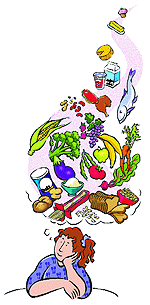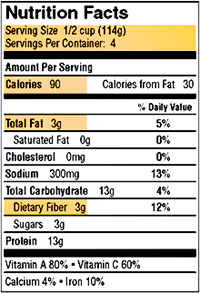| Table of Contents | ||||||||||||||||
|
Getting Started with Weight Management
Healthy Eating
Food is your body's fuel. You can't live without it. The key is to give your body enough nutrients and energy without eating too much. This sounds simple, but it can be hard to do in our food-obsessed culture. Help yourself by knowing what, when, why, and how you eat. Learning new eating habits will help you manage your weight.
What, When, Why, and How You Eat

Try some of the tips below:
- Don't skip meals. Skipping meals often leads to overeating later on. It's best to spread your eating throughout the day.
- Eat a variety of foods, not just a few favorites. Not only is this healthier, but it can help ward off cravings.
- If you find yourself eating when you're not hungry, ask yourself why. Many of us eat when we're bored, stressed, upset, tired, or just to be polite. Learn to listen to your body. If you're not hungry, get busy doing something else instead of eating. For instance, if you're bored, stressed, or upset, try going for a walk.
- Eat slower. It takes 20 minutes for your stomach to tell your brain that it's full. Eat slower, and you may find it easier to stop at one helping.
- Pay attention to what you eat. Don't read or watch TV during your meal.
|
Avoid this TRAP Avoid thinking of certain foods as "forbidden." If you like a food that's high in fat and calories, you can still eat it. Just savor a small amount and only have it once in a while. |
Eat Less Fat
You've probably heard that you should eat less fat. But do you know why? A gram of fat has almost twice the calories of a gram of protein or carbohydrates. Fat in your food can also contribute to health problems such as heart disease and some cancers. Try to balance your food choices so that no more than 30% of your calories comes from fat. This means an average of 3 grams of fat for each 100 calories you eat.
|
Avoid this TRAP Remember that low-fat foods still have calories! Don't fall into the trap of eating a whole box of cookies just because they're "low-fat" or "fat-free." |
Eat More Fiber
High-fiber foods are digested more slowly than lower-fiber foods, so you feel full longer. Try to get an average of 25 to 35 grams of fiber each day. Foods that are high in fiber include:
- Vegetables and fruits (not juice, which has little fiber)
- Whole-grain or bran breads, pastas, and cereals
- Legumes (beans) and peas
Drink Plenty of Water
Water is essential for life. Your body works better when it has the water it needs. Drinking enough water can help fill your stomach and make you feel less hungry. And water is needed to keep your digestive system working smoothly, especially if you begin to eat more fiber. Drinking more water won't make you gain "water weight." In fact, the more water you drink, the less likely your body is to retain water. Try to drink eight or more 8-ounce glasses of water every day. Instead of plain water, you can make some of your glasses no-calorie, no-caffeine flavored water, carbonated water, or herbal tea.
|
Try this TIP Keep water with you. Have a bottle of water in the car. Have one on your desk. And take one with you when you exercise. |
Understanding Food Labels

Most packaged foods are required to list certain information on the label. Knowing what to look for can help you make good food choices.
What to Look For
Serving Size and Servings Per Container: The serving size is the average portion. All the values on the label are based on one serving. Remember to multiply the values on the label by the number of servings you eat.
Calories: This shows the total number of calories in each serving.
Total Fat: The total grams of fat in each serving.
Fiber: The total grams of fiber in each serving.